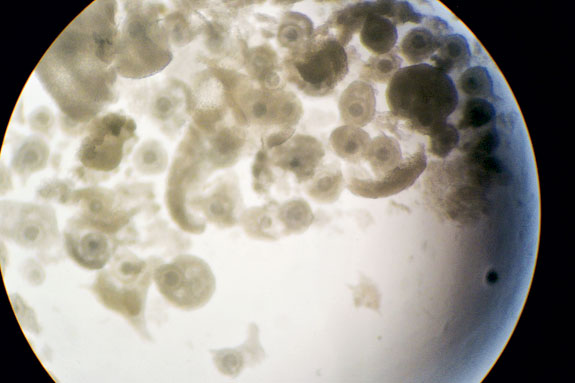Studies have shown that heat-stressed dairy cows suffer from damage to their ovarian follicles. Moreover, the eggs produced by the damaged follicles may also be damaged, says Dr. Todd Bilby, Texas AgriLife Extension Service dairy specialist. Worse, after becoming heat-stressed, other studies have shown the eggs she ovulates for the next 40 or 50 days are likely to be damaged as well, Bilby says.
Bilby and his graduate student, Brandi Stewart, have found a way to double pregnancy rates during the summer and increase the number of heifers born as compared with conventional artificial insemination commonly used on dairy farms. They believe this method could save dairies in Texas and throughout the country lots of money.
“If a lactating dairy cow’s egg actually becomes fertilized during summer, for which she only has a 50 percent chance, then there is still a very good chance the cow will not become pregnant because the early growing embryo is more likely to die within the first three days of life,” Bilby says.
For decades, modern dairies have relied mostly upon artificial insemination, using frozen sperm, to get cows pregnant as they come into heat. Since the late 1980s and early 1990s, embryo transfer systems – test-tube calves – have been used.
However, embryo transfers have issues of their own, Bilby says. The first issue used to be the cost of producing viable embryos by causing cows to super-ovulate – producing large numbers of eggs at one time – with fertility drugs. But today, there’s an alternative. Eggs can be harvested from slaughterhouse cows, then fertilized in the lab with semen from high-quality bulls. Several hundred eggs can be fertilized at a time at a greatly reduced cost over super-ovulation methods.

Bilby and Stewart recently published their work using embryo transfer in 722 cows from central-Texas dairies in the summer of 2009. The study compared fresh and frozen embryos that had been fertilized with sex-sorted semen, which is gender- biased towards more female sperm, and incubated for seven days before transferred to the mother cow.
Bilby and Stewart split the cows into approximately three equal-sized groups. One group was artificially inseminated with traditional methods. Another group received frozen embryos. The third group received fresh embryos.
All cows were estrus synchronized using standard methods. The artificial insemination group was bred using either timed schemes or following detected estrus. The other two groups had embryo transfers seven days after completion of the estrus synchronization protocol.
During a period of 40 to 47 days after the transfers, all cows were checked to see if they were pregnant. Of those receiving fresh embryos, about 42 percent were pregnant. Those receiving frozen embryos had a substantially lower pregnancy rate of about 29 percent. As expected, the artificial insemination group had the lowest pregnancy rate of about 18 percent.
Bilby and Stewart diagnosed the cows again at 90 to 104 days after treatment. As expected, they found an overall drop in pregnancy rates, but those receiving fresh embryos still had the highest pregnancy rate at more than 36 percent, compared to frozen embryos at about 28 percent and artificially inseminated at 17 percent.
“The use of in-vitro-produced embryos with sex-sorted semen can bypass the deleterious effects of heat stress on fertility while increasing the number of heifer pregnancies,” Bilby says. “This could be a viable option for producers to adopt to maintain fertility during summer months.”
Bilby also emphasizes that using fresh or frozen embryos paired with sex-sorted semen instead of artificially inseminating not only increased the number calves born, but also increased the number of heifers born. With frozen embryos, 80 percent of calves born were heifers, and 88 percent with fresh embryos, compared to 50 percent using artificial insemination. PD
— Excerpts from Texas AgriLife newsletter, Sept. 2010. Burns is a communications specialist with Texas AgriLife Extension.
PHOTOS:
TOP RIGHT: Brandi Stewart, a graduate student working on her master's degree at the Texas AgriLife Research and Extension Center in Stephenville, Texas, recovers eggs from ovaries harvested from slaughterhouse cows.
TOP LEFT: Eggs from slaughterhouse cows as seen through a microscope's eyepiece. Photos courtesy of Texas AgriLife Extension Service.






